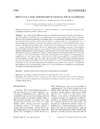Identificador persistente para citar o vincular este elemento:
https://accedacris.ulpgc.es/jspui/handle/10553/75419
| Campo DC | Valor | idioma |
|---|---|---|
| dc.contributor.author | Almeda, Rodrigo | en_US |
| dc.contributor.author | van Someren Gréve H | en_US |
| dc.contributor.author | Kiørboe T | en_US |
| dc.date.accessioned | 2020-11-11T14:22:10Z | - |
| dc.date.available | 2020-11-11T14:22:10Z | - |
| dc.date.issued | 2017 | en_US |
| dc.identifier.issn | 2150-8925 | en_US |
| dc.identifier.uri | https://accedacris.ulpgc.es/handle/10553/75419 | - |
| dc.description.abstract | Zooplankton exhibit different small-scale motile behaviors related to feeding and mating activ-ities. These different motile behaviors may result in different levels of predation risk, which may partiallydetermine the structure of planktonic communities. Here, we experimentally determined predation mortal-ity associated with (1) feeding activity (ambush feeders vs. feeding-current vs. cruising feeders) and (2)mate-finding behavior (males vs. females). The copepods Oithona nana, O. davisae (ambush feeders), Temoralongicornis (feeding-current feeder), and Centropages hamatus (cruising feeder) were used as prey for differ-ent predatory copepods. Copepods with “active” feeding behaviors (feeding-current and cruising feeders)showed significantly higher mortality from predation (~2–8 times) than similarly sized copepods with lowmotility feeding behavior (ambush feeders). Copepod males, which have a more active motile behaviorthan females (mate-seeking behavior), suffered a higher predation mortality than females in most of theexperiments. However, the predation risk for mate-searching behavior in copepods varied depending onfeeding behavior with ambush feeders consistently having the greatest difference in predation mortalitybetween genders (~4 times higher for males than for females). This gender-specific predation pressuremay partially explain field observations of female-biased sex ratios in ambush feeding copepods (e.g.,Oithonidae). Overall, our results demonstrate that small-scale motile behavior is a key trait in zooplanktonthat significantly affects predation risk and therefore is a main determinant of distribution and compositionof zooplankton communities in the ocean. | en_US |
| dc.language | eng | en_US |
| dc.relation.ispartof | Ecosphere | en_US |
| dc.source | Ecosphere [EISSN 2150-8925], v. 8(2), e01668 | en_US |
| dc.subject | 251001 Oceanografía biológica | en_US |
| dc.subject.other | Copepods | en_US |
| dc.subject.other | Motile behavior | en_US |
| dc.subject.other | Predation risk | en_US |
| dc.subject.other | Trait-based approach | en_US |
| dc.subject.other | Zooplankton | en_US |
| dc.title | Behavior is a major determinant of predation risk in zooplankton | en_US |
| dc.identifier.doi | 10.1002/ecs2.1668 | en_US |
| dc.relation.volume | 8 | en_US |
| dc.investigacion | Ciencias | en_US |
| dc.type2 | Artículo | en_US |
| dc.description.numberofpages | 20 | en_US |
| dc.utils.revision | Sí | en_US |
| dc.identifier.ulpgc | No | en_US |
| dc.contributor.buulpgc | BU-BAS | en_US |
| dc.description.sjr | 1,461 | |
| dc.description.jcr | 2,671 | |
| dc.description.sjrq | Q1 | |
| dc.description.jcrq | Q2 | |
| dc.description.scie | SCIE | |
| item.fulltext | Con texto completo | - |
| item.grantfulltext | open | - |
| crisitem.author.dept | GIR ECOAQUA: Ecofisiología de Organismos Marinos | - |
| crisitem.author.dept | IU de Investigación en Acuicultura Sostenible y Ec | - |
| crisitem.author.dept | Departamento de Biología | - |
| crisitem.author.orcid | 0000-0002-0090-112X | - |
| crisitem.author.parentorg | IU de Investigación en Acuicultura Sostenible y Ec | - |
| crisitem.author.fullName | Almeda García, Rodrigo | - |
| Colección: | Artículos | |
Los elementos en ULPGC accedaCRIS están protegidos por derechos de autor con todos los derechos reservados, a menos que se indique lo contrario.
